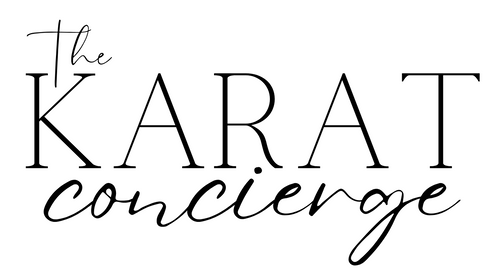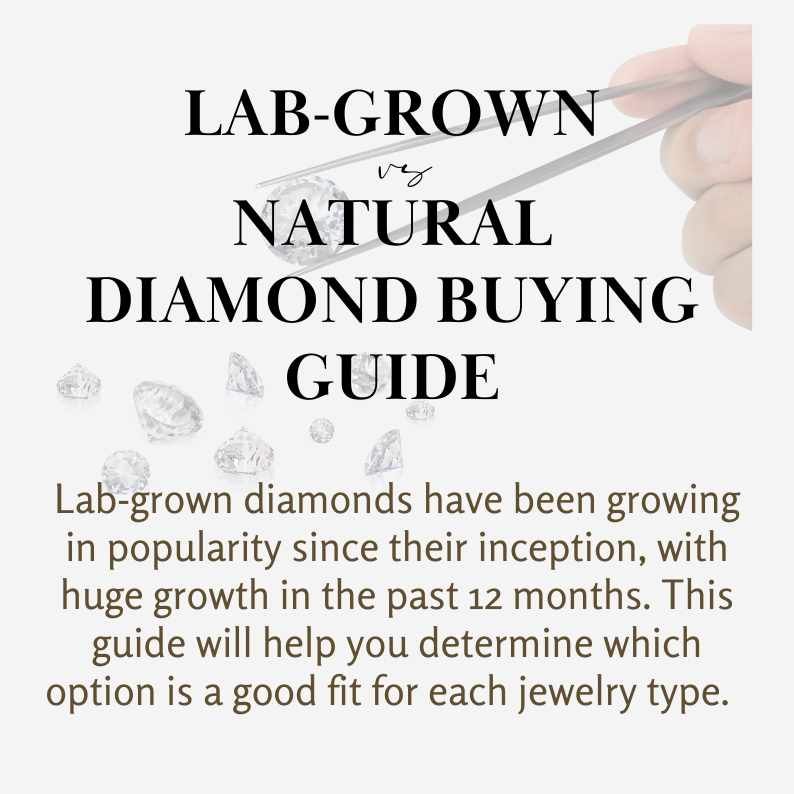The Differences Between Lab-Grown Diamonds and Natural Diamonds
In the world of fine jewelry, diamonds have long been celebrated for their brilliance and rarity. Traditionally, these gemstones have been mined from deep within the Earth, but recent technological advancements have introduced an intriguing alternative: lab-grown diamonds. While both types of diamonds hold their unique allure, they differ in several key aspects. In this document we will explore the differences between lab-grown diamonds and natural diamonds, considering their formation, characteristics, environmental impact, and market value.
Formation Process

The primary difference between lab-grown and natural diamonds lies in their formation.
Natural Diamonds: They are formed over billions of years under the Earth’s crust. Extreme heat and pressure about 100 miles below the Earth's surface transform carbon atoms into crystallized diamonds. These diamonds are then brought to the surface through volcanic eruptions, a process that can take millions of years.
Lab-Grown Diamonds: In contrast, lab-grown diamonds are created in controlled environments using advanced technological processes. The most common methods are High Pressure High Temperature (HPHT) and Chemical Vapor Deposition (CVD). These processes mimic the natural conditions of diamond formation but occur over a few weeks or months, not millennia.
Physical and Chemical Properties
Identical Composition: Both lab-grown and natural diamonds are made of crystalline carbon. This similarity means they share the same physical, chemical, and optical properties, including hardness, refractive index, and dispersion.
There can be microscopic inclusions or flaws unique to each type. For instance, lab diamonds might exhibit certain crystal growth patterns or metallic inclusions that are absent in natural stones.
Environmental Impact
The environmental impact of diamond production has been a concern for some consumers.
Natural Diamonds: Mining for natural diamonds can be environmentally taxing. It involves moving large amounts of earth, which can disrupt ecosystems, lead to soil erosion, and result in other ecological impacts.
Lab-Grown Diamonds: Lab-created diamonds have been promoted as a more sustainable option because they require significantly less earth movement and have a smaller overall environmental footprint.
Market Value and Perception

Rarity: Natural diamonds have a long history of being associated with luxury and status. As a result, they often command higher prices due to their perceived value and desirability. Natural diamonds have been and very likely will continue to be more valuable due to their rarity and the romanticism associated with their natural origin. Natural diamonds are finite resources, and their supply is controlled by mining companies. The rarity of natural diamonds keeps their price more stable than lab-grown diamonds. According to the National Diamond Council, the annual amount of natural 1 carat diamonds recovered would fit into 1 exercise ball, and the annual amount of 5 carat diamonds recovered would fit into one basketball(2).
Cost: Lab-grown diamonds are currently about ⅙ of the cost of an equal natural diamonds of similar size and quality. Prices of lab-grown diamonds have fallen over 75% since 2016(1) . This is due to many reasons, primarily the over saturation of lab grown diamonds in the market, the shorter supply chain and the absence of mining expenses.
Market Acceptance: While some purists still prefer natural diamonds for their unique history, lab-grown diamonds are gaining acceptance for their significant cost savings, identical look and chemical composition to natural diamonds, and their perceived ethical and environmental benefits.
Ethical Considerations
The diamond industry has faced criticism over ethical issues, including labor practices and conflict diamonds.
Natural Diamonds: While there has been a lot of discussion around the ethical considerations and labor practices with natural diamonds, what many consumers do not realize is that there have been processes put in place by The Kimberley Process Certification Scheme (KPCS).
- Under the Kimberley Process, which is mandated by the United Nations and the World Trade Organization, countries and diamond-producing regions implement strict controls and certification procedures for the export and import of rough diamonds. Diamonds must be transported in tamper-resistant containers with proper documentation, ensuring that they are conflict-free. Countries are required to establish systems for identifying and verifying the source of their diamonds. This helps ensure that diamonds are not originating from conflict zones or areas controlled by rebel groups. In addition to labor considerations, the Kimberley Process imposes a trade ban on rough diamonds from areas under rebel control or involved in conflict. This ban is intended to disrupt the financing of armed conflict through diamond sales. The Kimberley Process certification provides consumers with a level of assurance that the diamonds they purchase have not contributed to conflict or human rights abuses.
Lab-Grown Diamonds: Lab diamonds offer a conflict-free alternative, appealing to consumers who are concerned about the environmental and ethical implications of their purchases. In addition it's important to note that many lab grown diamond methods are not completely mining free, as they include the use of materials that are mined such as graphite and metals.
- Certification: Both natural and lab-created diamonds can be certified for their quality and characteristics.
FAQ's
- How do I know if I’m purchasing a natural or lab-grown diamond? The global standards are that diamonds are assumed natural unless they are labeled “lab” (laboratory-created or grown), or “synthetic”. The United States also allows the manufacturer’s name followed by the word created to signify a lab-grown diamond.
- Can you identify a lab-grown diamond by looking at it with the naked eye? NO. Lab-grown diamonds have the same chemical composition as natural diamonds and while most of them are created with low color ratings (meaning their color is whiter and they tend to have few to no inclusions visible to the naked eye) simply because they’re made in a more controlled environment, they still carry characteristics of the 4 C’s.
- Can diamonds be tested to determine whether they are lab-grown or natural diamonds? YES. Very easily with the right equipment which is readily available to jewelers.
- How do I know that a jeweler has not mis-represented a lab-created diamond as natural? This would be illegal. As mentioned, lab-grown diamonds are very easily detectable by jewelers with readily available diamond testers. Additionally, jewelers businesses are built on reputations and if they misrepresented a diamond, they would ruin their reputation with not only their client base, but also within the industry. Additionally, the profit margin for selling lab grown diamonds is significantly larger so there is a decreased incentive for a jeweler to misrepresent a diamond.
- Does the resale value of a lab-grown diamond remain similar to its market value? NO. Once a lab-grown diamond is purchased from a jeweler, it almost always looses its resale value. Due to the low cost and large supply of lab diamonds, there are very few jewelers who will buy back a lab diamond at any cost. When purchasing a lab diamond, you must be aware that you will likely not recoup any of the value with resale.
- Can I expect a 75% savings from natural diamond prices on all lab grown diamond jewelry? NO. The cost of jewelry is due to a combination of 3 seperate considerations.
- Cost of the stones- The cost of diamonds depends on whether they are lab or natural, the size of the stone (stone prices rise incrementally by size), and the stone characteristics, know as the 4 C’s.
- Cost of the metal- This includes whether the fine jewelry is set in platinum, yellow, white, or rose gold. Gold prices are currently at a high.
- Cost of the labor- Each fine jewelry piece requires a deign, manufacturing the setting which is a multi-step process, as well as setting the stones. Pieces with a large amount of stones, a complicated setting, or large stones will carry larger labor costs.
Keeping these 3 considerations in mind, while using lab diamonds may be a cost savings, there may be times when the savings is less because the majority of the cost of the item is higher in labor or gold costs. Your jeweler should advise you if cost is important to you if setting the fine jewelry in natural diamonds would be close in cost to setting it with lab-grown diamonds.
Conclusion
Lab-grown and natural diamonds each have their distinct places in the world of gemstones. While they are virtually indistinguishable in appearance and properties, the differences in their origin, environmental impact, cost, and ethical considerations set them apart. As technology advances and societal values evolve, the choice between lab-grown and natural diamonds will continue to be a personal one, influenced by a variety of factors. Ultimately, both types of diamonds offer their unique charm and allure, symbolizing beauty, durability, and timelessness.
While many fine jewelers avoided the lab-grown diamond market for years, I now believe there’s a place for both diamond types. The value of a natural diamond is in it’s rarity and while lab diamond prices have and continue to drop since their introduction into the market, natural diamond prices (while they have fluctuated with the market) have risen an average of 3% per year in the last 35 years.
Lab diamonds are not a safe investment and I strongly advise clients not to buy lab-created diamonds for any pieces that will be heirloom pieces, including engagement rings.
However, lab grown diamonds are a great option for everyday fine jewelry, trendy fine jewelry, jewelry to wear while traveling or that’s more likely to be lost (lets face it...), with the current trend of stacking fine jewelry, personalized fine jewelry, or to obtain the piece that you want, and finally for those that are seeking a piece of diamond jewelry with a softer impact on the enviroment. And while our economy may not be as strong today as it’s been in the past, lab grown jewelry is a less risky purchase simply because it’s a significantly lower cost.
The Karat Concierge is delighted to announce a new addition to our collection - lab-grown diamond options. Our commitment to offering the finest quality jewelry with a focus on affordability and sustainability has led us to expand our range to include these exceptional lab-grown diamonds, providing our customers with a stunning alternative that mirrors the brilliance and elegance of natural diamonds, while reinforcing our dedication to natural diamond offerings. While we introduce lab-grown diamonds to our collection, we want to assure our valued customers that our commitment to natural diamonds remains steadfast. We will continue to prioritize and focus on offering the highest quality natural diamonds, each a unique wonder of nature.
1- Paul Zimnisky (2023) State of the diamond market February 2023. Available at: https://www.paulzimnisky.com/state-of-the-diamond-market-past-issue-index
2- Natural Diamond Council (2021) Beyond the 4 C’s. Available at: https://www.naturaldiamondcouncil-academy.com/sites/default/files/2021-08/BEYONG%20THE%204C.pdf


